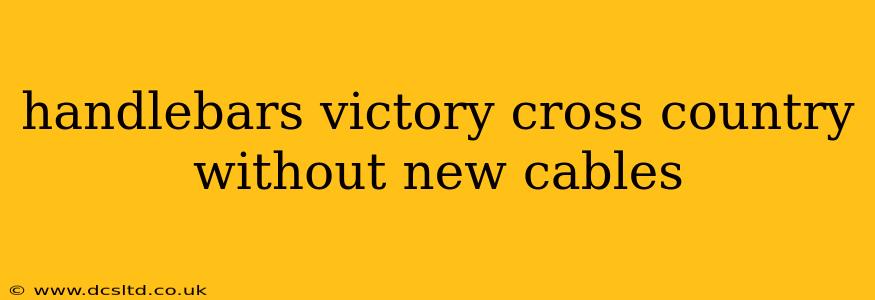Changing handlebars on your Victory Cross Country can significantly alter its riding experience, improving comfort and ergonomics. However, many riders worry about the potential hassle of replacing cables during this process. This guide will explore how to install new handlebars on your Victory Cross Country without necessarily needing new cables, focusing on techniques to maximize existing cable length and minimize potential issues. Remember, always consult your Victory Cross Country's service manual for detailed specifications and safety precautions.
Why Would I Need New Cables for Handlebar Replacement?
Replacing handlebars often requires new cables because the new bar position may stretch the existing cables beyond their operational limits. This can lead to binding, reduced throttle response, clutch issues, or even damage to the cables themselves. However, with careful planning and some adjustments, you might be able to avoid this expense.
Can I Reuse My Existing Cables? Assessing Your Situation
The feasibility of reusing your existing cables largely depends on the type of handlebars you're installing. A minor change in handlebar height or sweep might allow you to reuse the cables. Conversely, a significant change, such as going from a very low to a very high rise, will almost certainly necessitate new cables.
Here's how to assess your situation:
- Measure the cable length: Carefully measure the length of your existing cables from their attachment points on the handlebars to their attachment points on the motorcycle.
- Compare to new handlebar dimensions: Compare these measurements to the dimensions of your new handlebars. Account for the changes in rise, sweep, and pull. If the difference is minimal (within a few inches), it might be possible to reuse your cables.
- Consider cable routing: Examine how the cables are routed with your current handlebars. Sometimes, rerouting the cables can gain you a few inches of slack.
Techniques for Maximizing Existing Cable Length
If your assessment suggests it might be possible to reuse your existing cables, consider these techniques:
1. Cable Routing Optimization:
- Explore different routing options: Carefully inspect the frame and other components to see if there are alternative cable routing paths that might reduce the strain on your cables. Sometimes, small changes can make a big difference.
- Use cable guides: Consider adding additional cable guides to keep the cables neatly organized and prevent them from binding or stretching excessively.
2. Adjusting Cable Clamps:
- Loosen cable clamps: Slightly loosening the cable clamps at various points along the route can allow for some additional cable slack. However, ensure the cables remain securely fastened and do not become loose enough to interfere with other components.
3. Utilizing Cable Adjusters:
- Check for cable adjusters: Some Victory Cross Country models have cable adjusters built into the system. These allow you to fine-tune the cable length, potentially providing the necessary slack. Consult your service manual to understand how to use these adjusters safely and effectively.
When to Definitely Replace Your Cables
Despite your best efforts, you may need to replace your cables if:
- Significant handlebar changes: Significant changes in handlebar rise, sweep, or pull often necessitate new cables. It’s better to err on the side of caution to avoid safety hazards.
- Cable binding or kinking: If the cables bind or kink during installation, they need to be replaced. Forcefully pulling or manipulating kinked cables can cause irreversible damage.
- Insufficient slack: After attempting all optimization methods, if you still lack sufficient slack, installing new, correctly sized cables is crucial for safe operation.
Frequently Asked Questions (FAQs)
How much does it cost to replace handlebars and cables on a Victory Cross Country?
The cost depends on the specific handlebars chosen, labor costs, and whether new cables are required. Expect a range of costs depending on your mechanic and parts choices.
What tools do I need to replace the handlebars on my Victory Cross Country?
You'll likely need standard motorcycle tools, including wrenches, sockets, screwdrivers, and possibly a torque wrench to ensure proper tightening. Consult your service manual for a precise list of tools.
Can I install new handlebars myself, or should I take it to a mechanic?
While some riders with mechanical experience can perform this task themselves, it’s generally recommended to have a qualified mechanic handle the installation, especially if you are unsure about cable management.
What are the potential risks of installing handlebars without replacing cables?
The main risks are reduced throttle response, compromised braking, clutch issues, and potential cable damage leading to unsafe riding conditions.
By carefully assessing your situation, optimizing cable routing, and making smart decisions, you might be able to successfully install new handlebars on your Victory Cross Country without the added cost and hassle of completely replacing the cables. However, safety should always be your priority. If you're unsure at any point, consult a qualified mechanic to avoid potentially dangerous complications.
